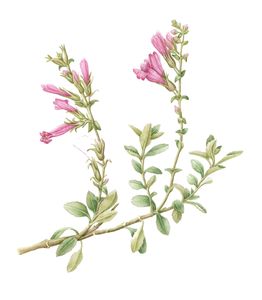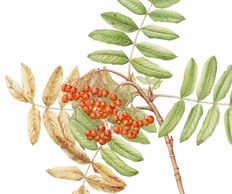MINERAL KING VALLEY

The Road ends in the Mineral King Valley, the “Jewel in the Crown”. Created by glaciers, the valley is surrounded by mountain peaks, many over 13,000 feet. The east fork of the Kaweah River begins at the southern end of the valley at Farewell Gap and flows through the center of the valley fed by five streams that cascade into the valley. Four of the streams--Monarch, Crystal, Franklin, and Eagle--flow from alpine lakes in the surrounding mountains. The fifth, Spring, is an actual spring that gushes out of a large hole about 1,000 feet above the valley floor.
The growing season in the Mineral King Valley is very short, from June through August. Many plants that bloom in the valley in June, then bloom at progressively higher altitudes with the passing summer weeks. Certain plants, however, grow only at the higher altitudes (9,000-11,000 feet) of the Mineral King Valley; Coville’s Columbine is found only at the tree line growing out of the rock; it is difficult to understand how such a delicate flower survives in such a harsh evironment. Heather and Mountain Laurel also grow primarily in Alpine environments above 9,000 feet. The beautiful and old Fox Tail Pines are the only trees to be found at the tree line.
The first plants to bloom in May & June are predominantly shades of blue: Languid Ladies, Stickseed, Larkspur, and Lupine. In July and August the colors change to yellow, red, and white: Paintbrush, Sierra Lily, Goldenrod, Bigelow’s Sneeze Weed, Cone Flower, Blazing Star, Geranium, and Corn Lily. During August, September and October many plants produce a variety of berries, pods and cones: Mountain Ash, Twin Berry, Elderberry, Currant, Gooseberry, Snowberry, Baneberry, Manzanita, and Service Berry.
Newberry's Penstemon

Penstemon newberryi
Penstemon is the largest genus of flowering plants endemic to North America with more than 250 species, 50 of which occur in California. Penstemon flowers have four stamens and one infertile staminode, hence the name Penstemon, meaning 5 stamens. P. Newberryi is named after John Stron Newberry (1822-1892), a botanist, geologist and paleontologist who collected in Callifonia on the Williamson Railroad Survey.
Snow Plant

Sarcodes Sanquinea
The Snow Plant is one of the first plants to appear in the Sierra Nevada in early spring. The brilliant red color is quite shocking and unexpected. The botanical name, Sarcodes sanguinea, means bloody flesh. The Snow Plant is unable to photosynthesize. It is a parasitic plant that has a symbiotic relationship with the mycorrhizal fungi that attach to the roots of trees. The snow plant provides fixed carbon to the fungus and in return the fungus provides mineral nutrients and water . The Snow plant takes advantage of this relationship by stealing sugars from the tree, the photosynthetic partner.
MINERAL KING VALLEY

Western Mountain Ash
Sorbus californica

Giant Blazing Star
Mentzelia laevicaulis

Davidson's Fritillary
Fritillaria pinetorum

Black Cottonwood with Warbling Vireo Nest
Populus balsamiferia with a nest of Vireo gilvus

Leichtlin's Mariposa Lily
Calochortus leightlini

Jeffrey Shooting Star
Dodecatheon jeffreyi
MINERAL KING VALLEY

Bigelow's Sneezeweed
Helenium biglovii

California Cone Flower
Rudbeckia california

Languid Ladies or Mountain Bluebells
Mertensia ciliata

Explorer's Gentian
Gentiana calycosa

Sierra Lily
Lilium kelleyanum

Meadow Penstemon
Penstemon rydbergiii
Copyright © 2018 joankeesey - All Rights Reserved.